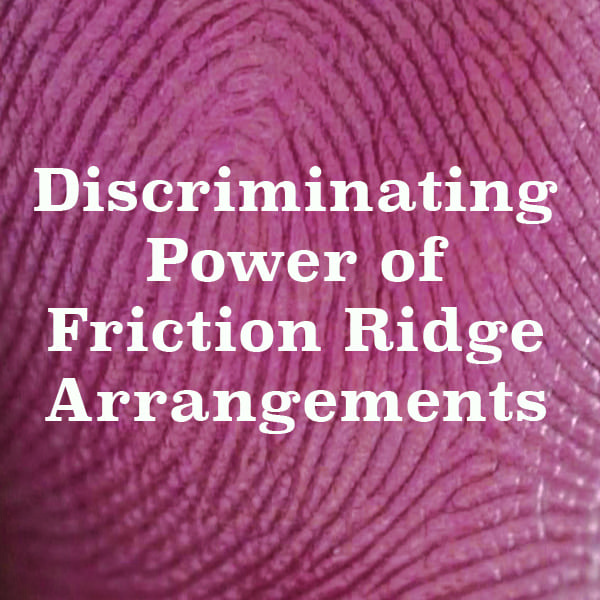Discriminating Power of Friction Ridge Arrangements (03/12/2025 9am-1pm PDT)
Enter the number of attendees in the quantity field and click “Add to cart”. At Checkout, you will be prompted for Billing information and the webinar Attendee information.
Click here to print or download webinar details: WEBINAR FLYER
Instructor: Alice White
Did you know the suggestion that “ridge units line up to form ridges” is based on a historical theory proposed in biology in the 1800’s called the theory of recapitulation? Although the theory of recapitulation was handed a death knell in the mid-1900’s by the budding field of genetics, the idea that “ridge units line up to form ridges” continued into the afterlife via the friction ridge discipline. In reality, embryologists have never observed ridge units lining up to form ridges in the friction ridge skin.
The following questions will be explored in this lecture: Based on actual observations from embryologists, what is the sequence of events that leads to the formation of the friction ridge skin? What is developmental noise? What is developmental stability? What is fluctuating asymmetry? Why are some aspects of the friction ridge skin useful for determining the anatomical origin (finger, palm, foot) and distal orientation (up) of a latent print? Why are the arrangements of the ridges in the friction ridge skin highly discriminating? Which features of the friction ridge skin do twins tend to share in common and why? Why do people have different fingerprints on their own fingers? Why do pattern force regions tend to have a high density of common minutiae (ending ridges and bifurcations) all pointing the same direction? Why do thumbs and index fingers have more minutiae, and more variety of complex minutiae, than the other fingers? Everything starts with the skin…
Learning Outcomes:
- The attendee will be able to recognize the following: surface ridge, surface furrow, primary ridge, and secondary ridge.
- The attendee will be able to list the factors that influence human variation.
- The attendee will be able to define developmental stability and developmental noise.
- The attendee will be able to indicate the three major contributors to friction ridge skin growth stresses.
- The attendee will be able to list the basic sequence of events during the formation of the friction ridges.
- The attendee will be able to identify factors that create low specificity or high specificity combinations of ridge features.
- The attendee will be able to identify the reasons monozygotic twins share remarkable similarity in patterns and ridge counts on corresp onding fingers.
- The attendee will be able to recognize regional variation in minutiae directions.
- The attendee will be able to recognize regional variation of minutiae densities.
Course Handout
Prior to the webinar (typically 1 – 2 days) you will receive an email link to a file or folder to download the handout and any relevant supplemental information. The main course handout can also be downloaded from the webinar platform at the time of the webinar.
Assessing Learning Outcomes (a.k.a. Quiz)
In order to verify the learning outcomes have been achieved, there is a 20-question quiz via SurveyMonkey at the end of each webinar. Attendees must score a minimum of 70% on the quiz in order to receive a training certificate for the webinar. Please note the quizzes are open-book and poll questions are given during the webinar to prepare attendees for the quiz.
Attendance Policy
This webinar may only be attended by the person who is registered for the webinar. Evolve Forensics does not permit broadcasting, watching, listening, or distributing the webinar or any of the webinar handouts to individuals who are not registered for this webinar.
Software Requirements: Attendees must be able to access GoToWebinar (webinar platform) and SurveyMonkey (quiz platform) in order to participate.
The following YouTube Video shows how to use GoToWebinar as an attendee: https://youtu.be/IQ3Xwwgbd8Y
Questions?
Please contact Alice White via email at [email protected]

